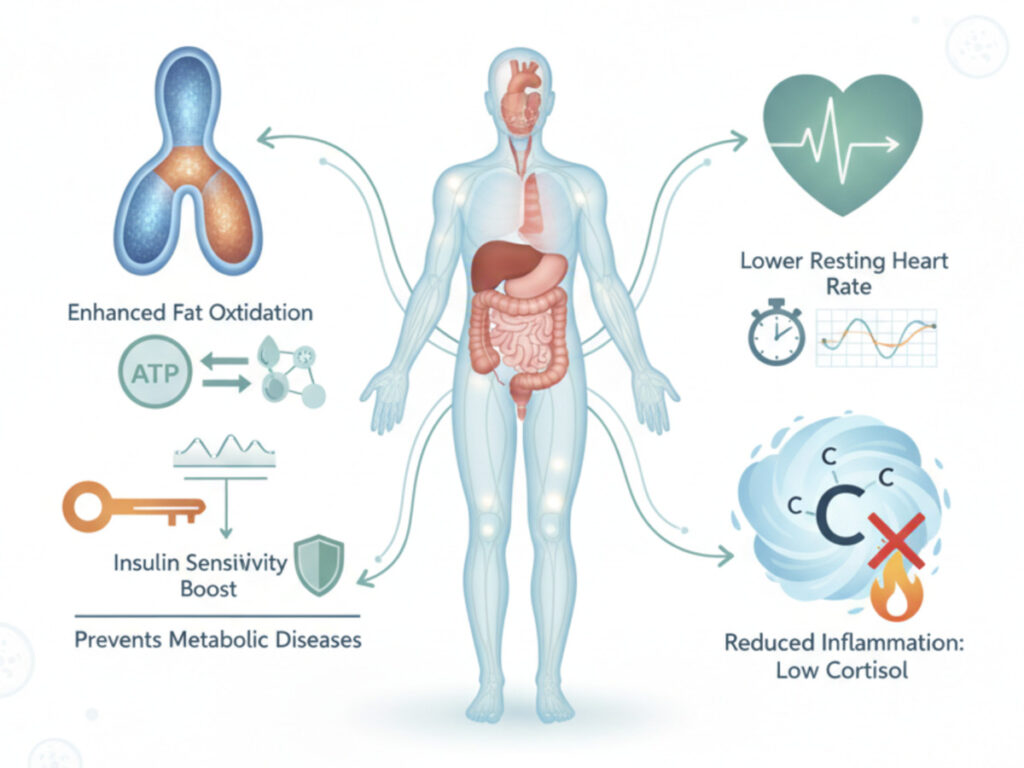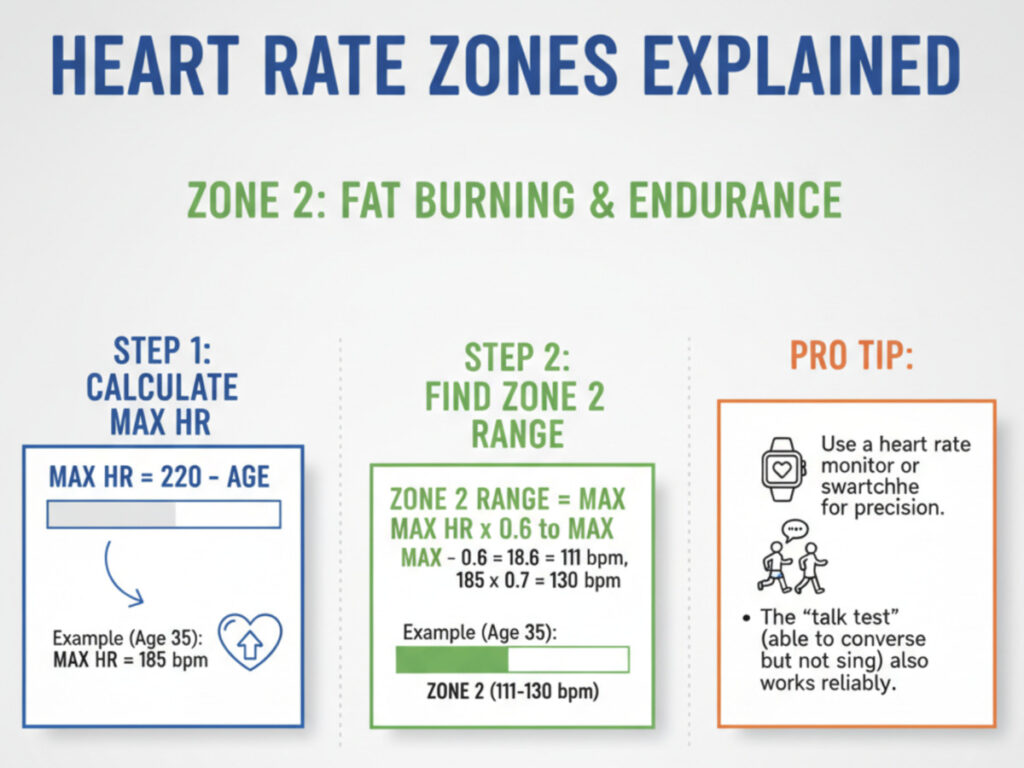Introduction
In 2025, fitness conversations have shifted from aesthetics to longevity, metabolic health, and sustainable performance. Among all the new training philosophies, Zone 2 cardio stands out as one of the most evidence-backed and yet underutilized approaches.
This method of low-intensity endurance training targets the body’s aerobic system to enhance fat-burning efficiency, mitochondrial function, and overall metabolic resilience. For busy Americans seeking sustainable energy and long-term fitness, Zone 2 offers a science-based, low-stress solution that’s easy to maintain.
What Exactly Is Zone 2 Cardio?
Your heart rate can be divided into five zones, each representing a percentage of your maximum heart rate (MHR).
Zone 2 typically equals 60–70% of your MHR, the sweet spot where the body efficiently uses fat as its primary energy source.
Table: Heart Rate Zones Overview
| Zone | % of Max HR | Intensity | Primary Fuel | Training Focus |
|---|---|---|---|---|
| Zone 1 | 50–60% | Very Light | Fat | Recovery |
| Zone 2 | 60–70% | Light | Fat | Endurance, Metabolic Health |
| Zone 3 | 70–80% | Moderate | Fat/Carbs | Aerobic Power |
| Zone 4 | 80–90% | Hard | Carbs | Performance |
| Zone 5 | 90–100% | Max Effort | Carbs | Anaerobic Power |
At this level, you can speak comfortably but not sing. Activities like brisk walking, easy cycling, rowing, or slow jogging typically fall into Zone 2.
The Science Behind Zone 2 Training
Zone 2 cardio primarily targets Type I (slow-twitch) muscle fibers, which are rich in mitochondria—the “powerhouses” of your cells.
According to research from the Journal of Applied Physiology, Zone 2 workouts increase mitochondrial density, leading to better oxygen utilization and fat metabolism.
Key physiological benefits:
- Enhanced fat oxidation: Improves the body’s ability to use fat for energy at rest and during exercise.
- Insulin sensitivity boost: Supports stable blood sugar levels and prevents metabolic diseases.
- Lower resting heart rate: Indicates stronger cardiovascular health.
- Reduced inflammation: Low-intensity workouts don’t overproduce cortisol.
In short, Zone 2 builds the foundation that supports all other training intensities.

Why Zone 2 Is the Secret to Longevity
Modern longevity experts, including Dr. Peter Attia and Dr. Iñigo San-Millán, emphasize Zone 2 as the cornerstone of long-term health.
They suggest that consistent Zone 2 cardio:
- Improves VO₂ max, a key biomarker for lifespan.
- Enhances metabolic flexibility, allowing the body to switch between fat and carb burning efficiently.
- Reduces risk of heart disease, diabetes, and cognitive decline.
Unlike high-intensity workouts, which can be taxing and unsustainable, Zone 2 training is gentle enough to practice daily without burnout—making it perfect for both beginners and high performers.
Zone 2 vs. High-Intensity Training: Key Differences
| Aspect | Zone 2 Cardio | HIIT (High Intensity) |
|---|---|---|
| Intensity | Low | Very High |
| Duration | 45–75 mins | 10–25 mins |
| Energy Source | Fat | Carbohydrates |
| Recovery Need | Minimal | High |
| Focus | Endurance, Longevity | Power, Speed |
| Injury Risk | Low | Moderate to High |
Verdict: For long-term health and consistency, Zone 2 reigns supreme. HIIT has its place but should complement—not replace—your aerobic base.
Finding Your Zone 2 Heart Rate
To estimate your Zone 2 range:
- Step 1: Calculate Max HR = 220 – your age.
- Step 2: Multiply by 0.6 and 0.7 to get your Zone 2 range.
Example:
For a 35-year-old → Max HR = 185 bpm
Zone 2 Range = 111–130 bpm
Pro Tip:
Use a heart rate monitor or smartwatch for precision. The “talk test” (able to converse but not sing) also works reliably.

How Often and How Long Should You Train?
To reap the metabolic and longevity benefits, experts recommend:
- Frequency: 3–5 sessions per week
- Duration: 45–60 minutes per session
- Progression: Gradually increase duration before intensity
For busy individuals, even two 30-minute sessions combined with daily walking can produce measurable improvements.
Common Mistakes to Avoid
- Going too hard: Exceeding Zone 2 shifts your body into carb-burning mode.
- Neglecting consistency: Zone 2 is about frequency, not intensity.
- Skipping recovery: Sleep and hydration amplify Zone 2 gains.
- Ignoring nutrition: Pair Zone 2 with a nutrient-dense, whole-food diet to optimize fat metabolism.
Tools & Tech to Optimize Zone 2 Workouts
- Garmin or Polar heart rate monitors – accurate heart zone tracking.
- Zone 2 training apps – like HRV4Training or Athlytic for recovery insights.
- Treadmills and stationary bikes – maintain controlled, steady-state intensity.
Real-Life Expert Insights
“Zone 2 cardio is the single most overlooked tool for improving metabolic health. It’s not about crushing workouts—it’s about training smarter.”
— Dr. Peter Attia, The Drive Podcast
“Athletes and patients alike benefit from building their aerobic base first. Zone 2 enhances every other zone.”
— Dr. Iñigo San-Millán, Exercise Physiologist, University of Colorado
FAQs
Q1. Is Zone 2 cardio only for athletes?
No. It’s ideal for all fitness levels, especially beginners seeking metabolic stability and endurance.
Q2. Can walking count as Zone 2?
Yes—if it raises your heart rate to 60–70% of your max HR. Incline walking works best.
Q3. Should I combine HIIT and Zone 2?
Yes. Do 80% Zone 2 and 20% HIIT for optimal results—a principle known as the 80/20 endurance rule.
Q4. Can Zone 2 help with weight loss?
Absolutely. It enhances fat utilization, leading to sustainable body composition improvements.
Actionable Checklist
✅ Calculate your Zone 2 heart rate range.
✅ Schedule at least 3 Zone 2 sessions weekly.
✅ Use a heart rate tracker for accuracy.
✅ Combine with proper nutrition and hydration.
✅ Track progress in endurance and resting heart rate.
Authoritative Resources
- American College of Sports Medicine (ACSM)
- Journal of Applied Physiology
- Peter Attia – The Drive Podcast
- World Health Organization: Physical Activity Guidelines

